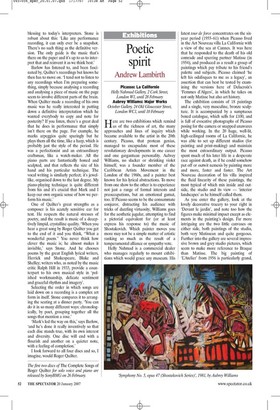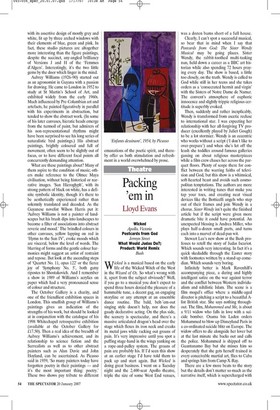Poetic spirit
Andrew Lambirth Picasso: La Californie Helly Nahmad Gallery, 2 Cork Street, London Wl, until 28 Febinaly Aubrey Williams: Major Works October Gallery, 24 Old Gloucester Street, London WC1, until 10 February Here are two exhibitions which remind us of the richness of art, the many approaches and lines of inquiry which became available to the artist in the 20th century. Picasso, that protean genius, managed to encapsulate most of these revolutionary developments in one career and one gargantuan personality. Aubrey Williams, no slacker or shrinking violet himself, was a founder member of the Caribbean Artists Movement in the London of the 1960s, and a painter best known for his lyrical abstractions. To move from one show to the other is to experience not just a range of formal interests and preoccupations, but an emotional gamut, too. If Picasso seems to be the consummate conjuror, distracting his audience with tricks of dazzling virtuosity, Williams goes for the aesthetic jugular, attempting to find a pictorial equivalent for (or at least express his response to) the music of Shostakovich. Which painter moves you more may not be a simple matter of artistic ranking so much as the result of a temperamental alliance or sympathy vote.
Helly Nahmad is a commercial dealer who manages regularly to mount exhibitions which would grace any museum. His latest tour de force concentrates on the sixyear period (1955-61) when Picasso lived in the Art Nouveau villa La Californie with a view of the sea at Cannes. It was here that he responded to the death of his old comrade and sparring partner Matisse (in 1954), and produced as a result a group of paintings which pay tribute to his friend's palette and subjects. Picasso claimed 'he left his odalisques to me as a legacy', an assertion that can best be tested by examining the versions here of Delacroix's 'Femmes d'Algers', in which he takes on not only Matisse but also art history.
The exhibition consists of 18 paintings and a single, very masculine, bronze sculpture. It is accompanied by a sumptuous boxed catalogue, which sells for £100, and is full of evocative photographs of Picasso posing for the camera or snapped unawares while working. In the 20 huge, well-lit, high-ceilinged rooms of La Californie, he was able to set up different studios (for painting and print-making) and maintain the most extraordinary output. Picasso spent much of his later life in a desperate race against death, as if he could somehow put off or outwit nemesis by painting more and more, faster and faster. The Art Nouveau decoration of his villa inspired the fluid linearity of these paintings, the most typical of which mix inside and outside, the studio and its view — 'interior landscapes' as he himself called them.
As you enter the gallery, look at the lovely decorative tracery to your right in Devant le jardin', and note too how the figures make minimal impact except as elements in the painting's design. Far more intriguing are the two little canvases on either side, both paintings of the studio, both very Matissean and quite gorgeous. Further into the gallery are several impressive brown and grey studio pictures, which seem to make more reference to Braque than Matisse. The big painting of `EAtelief from 1956 is particularly grand, with its assertive design of mostly grey and white, lit up by three arched windows with their elements of blue, green and pink. In fact, these studio pictures are altogether more interesting than the figure paintings, despite the succinct, any-angled brilliancy of Versions J and H of the 'Femmes d'Algers'. Interestingly, it's the two little gems by the door which linger in the mind.
Aubrey Williams (1926-90) started out as an agronomist in Guyana with a passion for drawing. He came to London in 1952 to study at St Martin's School of Art, and exhibited widely from the early 1960s. Much influenced by Pre-Columbian art and artefacts, he painted figuratively in parallel with his experiments in abstraction, but tended to show the abstract work. (In some of his later canvases, hieratic heads emerge from the turmoil of paint, but admirers of his non-representational rhythms might have been surprised to see his long series of naturalistic bird paintings.) His abstract paintings, brightly coloured and full of movement, often seem to be slightly out of focus, or to have different focal points all concurrently demanding attention.
What are these paintings about? Many of them aspire to the condition of music; others make reference to the Olmec Maya civilisation, without being historical or narrative images. 'Sun Hieroglyph', with its strong pattern of black on white, has a definite symbolic identity, though it's there to be aesthetically experienced rather than solemnly translated and decoded. As the Guyanese novelist Wilson Harris put it: 'Aubrey Williams is not a painter of landscapes but his brush dips into landscapes to become a filter of associations into abstract reverie and mood.' The brindled colours in other canvases, yellow lapping on red in 'Hymn to the Sun IV', evoke moods which are visceral, below the level of words. The blurring of forms and the gentle colour harmonies might suggest an artist of restraint and repose. But look at the ascending steps of 'Quartet No. 11, opus 122' or the fierce joy of 'Symphony No. 5', both gutsy ripostes to Shostakovich. And I remember a show in 1989 of Williams's acrylics on paper which had a very pronounced sense of colour and structure.
The October Gallery is a charity, and one of the friendliest exhibition spaces in London. This smallish group of Williams's paintings gives an indication of the strengths of his work, but should be looked at in conjunction with the catalogue of his 1998 Whitechapel retrospective exhibition (available at the October Gallery for £17.50). Then a real idea of the breadth of Aubrey Williams's achievement, and its relationship to science fiction and the Surrealists as well as to other abstract painters such as Alan Davie and John Hoyland, can be ascertained. As Picasso said in 1959, 'So many painters today have forgotten poetry in their paintings — and it's the most important thing: poetry.' These two shows pay tribute to different emanations of the poetic spirit, and thereby offer us both stimulation and refreshment in a world overwhelmed by prose.






















































 Previous page
Previous page